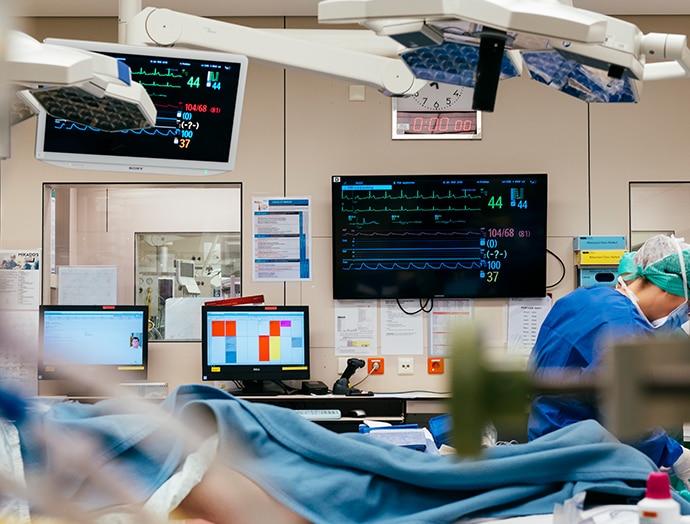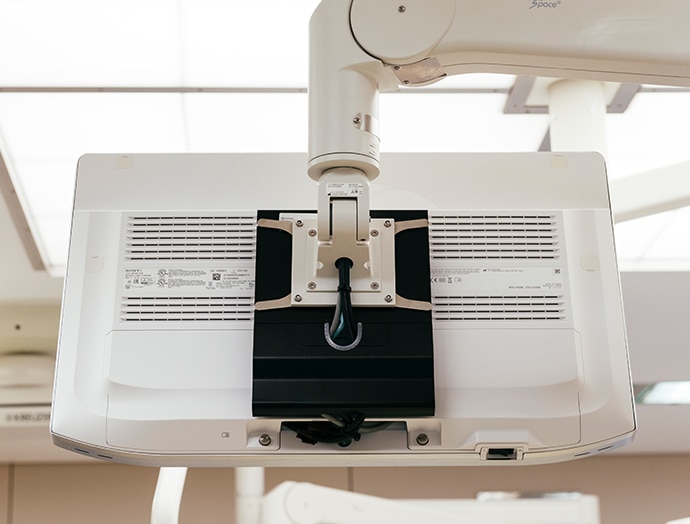NUCLeUS™ streamlines surgical workflow at UZ Leuven
Our NUCLeUS video-over-IP platform is enhancing ergonomics and team cooperation in operating rooms and treatment rooms at one of Belgium’s leading university hospitals. The system allows surgeons and clinical staff at UZ Leuven to route live video sources to any screen in the operating room, share with other locations or record content for sharing.

- University Hospitals Leuven (UZ Leuven) is a leading teaching hospital with almost 2,000 patient beds and around 1,500 physicians
- Routing and recording video footage from surgery required dedicated equipment and time-consuming re-plugging of cables
- NUCLeUS system installed in 34 digital operating rooms and other hospital areas
- Video streams from endoscopic cameras and other sources can be viewed locally or routed across the hospital’s IT network
- Content is recorded on central server for post-operative analysis, teaching and training
- Our NUCLeUS video-over IP platform helps clinical teams perform thousands of surgical interventions each year
- Simplifies cable routing and allows more efficient use of operating room resources
- Live video can be patched instantly to any destination in the operation room or outside
Contact us for more information
A neurosurgeon might be positioned over a patient, looking into a microscope and relying on a nurse to hand them operating instruments. If that nurse can see what the surgeon is seeing, they can anticipate their needs much better. NUCLeUS improves that all-important cooperation within the whole team.
Professor Erwin Bellon
IT Manager Multimedia & Telematics, UZ Leuven

Any video source, any screen
NUCLeUS is installed in 34 fully-digital Operating Rooms, where the easy-to-use system allows any image source to be routed to any display as needed. It also features eight ambulatory surgery rooms, three eye surgery rooms and eleven endoscopy rooms where the system is used primarily for image capture and recording. For this application, it’s linked with video sources at two partner hospitals up to 80km away.
“The modern OR is a busy place, with a lot going on” says Professor Erwin Bellon, IT Manager Multimedia & Telematics at UZ Leuven. “There is a lot of equipment – endoscopy, patient monitoring, ultrasound and more – each typically with its own dedicated screen. As a surgeon operating in a relatively confined space, you have to be like a contortionist sometimes, constantly turning your head and changing position to look at all these different screens. With NUCLeUS it’s so much easier for the surgeon to see any image they need – whether it’s radiology, vital signs or whatever – on a nearby monitor.”
Simpler cabling, more efficient use of resources
NUCLeUS offers several benefits to UZ Leuven’ surgical and nursing teams, while offering extra flexibility and attractive economies of scale to IT staff.
As any type of video source is digitised into an IP stream and carried by a universal network cable, physical connections between equipment become simpler. And as additional network outlets are relatively inexpensive, there’s always a nearby outlet that mobile equipment can be plugged into.
Since the arrival of NUCLeUS, dedicated video recording equipment has disappeared from the room. Recording is performed by servers located hundreds of metres away – rather than taking up valuable space in the OR while generating heat and dust.
In addition to economies of scale, the IP based system’s flexibility also makes it attractive for IT and engineering staff. “Previously, if a surgeon wanted video footage of a procedure – for sharing with colleagues or presenting at a conference – that involved disconnecting a lot of cables”, comments Kris Schoonjans of the Department of Clinical Engineering. “And to stream video to the auditoria for a workshop, we had to bring video conferencing equipment into the OR. Now it’s so much simpler – and with superior image quality.”
“And as NUCLeUS offers APIs, images or video can be imported automatically into our medical record”, adds Professor Bellon. “We’re already looking forward to when the additional power of real-time image processing – for example to improve the visibility of fine blood vessels and vascular structures – can be added as a network-wide service in medical routine.”


Improving communication in the OR
As well as offering improved ergonomics for surgeons, NUCLeUS allows better cooperation between all members of the surgical team. Giving everyone in the OR a clear picture of what’s happening delivers big ergonomic benefits, as Professor Bellon illustrates:
“A neurosurgeon might be positioned over a patient, looking into a microscope and relying on a nurse to hand them operating instruments. If that nurse can see what the surgeon is seeing, they can anticipate their needs much better. Similarly, the operator of a heart-lung machine is typically standing somewhere in a corner behind the equipment, yet must coordinate with the surgeon’s actions. NUCLeUS improves that all-important cooperation within the whole team.”
“As well as its great value in teaching, NUCLeUS has made it easier for doctors to gain consensus on a tricky procedure or seek advice from their colleagues” comments Philippe Koninckx, Professor of Obstetrics & Gynaecology who has worked for many years at UZ Leuven. “Without leaving their office, a tutor can keep an eye on the work of more junior surgeons in the OR. Also, making it so simple to call a colleague dramatically lowers the barriers to requesting advice”.
Crucially, the open architecture of NUCLeUS does not commit UZ Leuven to using imaging modalities from a specific manufacturer. The system can accommodate virtually any kind of video source, in any format or resolution. Clinical staff are also impressed by the reliability of the hospital-wide system: “They just expect it to work!” concludes Professor Bellon.



